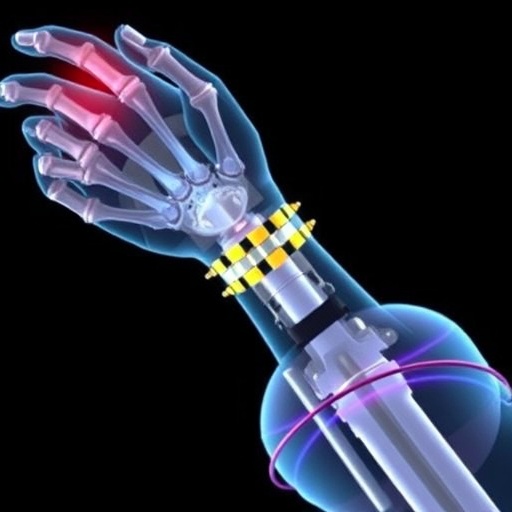A groundbreaking advancement in neuroprosthetics is set to transform rehabilitation for stroke survivors struggling with hand motor deficits. Researchers have unveiled a novel self-triggered grasp neuroprosthesis designed specifically to restore prehension functions in individuals with hemiparesis following a stroke. This innovative device leverages diverse control modalities to enable intuitive, real-time stimulation of finger extensor muscles, thereby facilitating grasping abilities that many patients have long lost despite traditional rehabilitation efforts.
Stroke remains the foremost cause of acquired motor impairments globally, leaving countless adults with compromised hand function. Recovery of active hand opening has proven particularly elusive for many, limiting their independence in daily activities. Addressing this gap, the newly developed grasp neuroprosthesis (GNP) prototype integrates self-triggering mechanisms attuned to the unique neuromuscular patterns of post-stroke individuals. The system’s adaptability aims not only to enhance usability but also to significantly improve real-world functional outcomes.
At the heart of this technology lies "NeuroPrehens," a sophisticated software platform that interprets user intent through an array of sensor inputs. These inputs include electromyographic (EMG) signals from targeted muscles, inertial measurement units (IMU) that detect precise motion patterns, foot switches, and even voice commands. By analyzing these signals in real time, the system activates an external functional electrical stimulator (FES) via surface electrodes positioned over finger extensor muscles, triggering controlled hand opening movements.
Deployment of the GNP was tested across two clinical research protocols involving 22 stroke survivors. Participants engaged with the device for multiple sessions over a week, during which they experienced nine distinct control modalities. Subjective evaluations focusing on ease-of-use and reliability revealed a strong preference for engaging the non-paretic foot as a triggering source—whether through EMG or IMU signals. Remarkably, both modalities received median ratings of 9 or 10 out of 10, underscoring their practicality and acceptance among users.
Further analysis assessed the temporal responsiveness of the GNP system. It revealed remarkably swift transitions from user intent to electrical stimulation, with median latencies measured at 217 ms for EMG-triggered commands and 333 ms for IMU-based detection. Even voice control—though slightly slower at 467 ms median latency—offered a viable hands-free alternative. Such rapid responsiveness is critical for ensuring that grasp initiation feels natural and synchronous with the user’s voluntary actions.
Functional impact was rigorously evaluated through standardized unimanual prehension tasks performed in a controlled, seated setting. Here, the GNP demonstrated a significant capacity to restore grasp capability, with improvements of up to three points on a five-point functional scale. This evidence supports the system’s real-world efficacy beyond laboratory metrics, suggesting meaningful gains in patients’ ability to perform everyday activities that require hand function.
The technology’s design focused not only on technical performance but also on ensuring practical deployment in the real lives of stroke survivors. By enabling users to select their preferred control modality from a versatile array of options, the neuroprosthesis accommodates individual differences in residual motor control and personal comfort. This user-centric approach could spur higher compliance and sustained use, essential factors in long-term rehabilitation success.
Another notable advancement lies in the device’s portability and envisaged home use. While the current prototype operates within a clinical setting, ongoing development efforts aim to create a wearable, self-contained version. Such iteration would facilitate continuous hand function support outside therapeutic environments, broadening the therapeutic reach and fostering patient autonomy in domestic contexts.
The study’s robust methodological framework—employing blinded evaluation, multi-crossover N-of-1 randomized controlled trials—adds credibility to the findings. The use of video analysis to assess functionality ensures objective, detailed appraisal of the neuroprosthesis’ impact on hand movements. This rigorous validation underscores the potential for clinical translation and widespread adoption.
Despite promising outcomes, challenges remain in ensuring seamless integration of the technology into diverse patient populations. Fine-tuning the algorithms to account for variability in user muscle activation patterns and motion signatures will be crucial. Moreover, user training protocols must be optimized to shorten acclimation periods while maximizing functional gains.
Envisioning future applications, this neuroprosthesis platform could inspire a new generation of adaptive assistive devices addressing various neuromotor impairments. Its modular control modalities and responsive stimulation strategies provide a versatile blueprint for restoring voluntary movements in patient groups beyond post-stroke populations, including those with spinal cord injuries or neurodegenerative diseases.
In conclusion, the development of this self-triggered grasp neuroprosthesis represents a significant leap toward practical, user-friendly restoration of hand function after stroke. Through advanced sensor integration, rapid responsiveness, and demonstrable functional improvements, the device holds promise to redefine rehabilitation paradigms. Continued innovation aimed at wearable deployment and personalized control strategies may soon enable stroke survivors to reclaim critical aspects of their independence and quality of life.
Subject of Research: Development and functional evaluation of a self-triggered grasp neuroprosthesis for restoring prehension in hemiparetic post-stroke individuals
Article Title: Specifications and functional impact of a self-triggered grasp neuroprosthesis developed to restore prehension in hemiparetic post-stroke subjects
Article References:
Le Guillou, R., Froger, J., Morin, M. et al. Specifications and functional impact of a self-triggered grasp neuroprosthesis developed to restore prehension in hemiparetic post-stroke subjects. BioMed Eng OnLine 23, 129 (2024). https://doi.org/10.1186/s12938-024-01323-y
Image Credits: AI Generated




